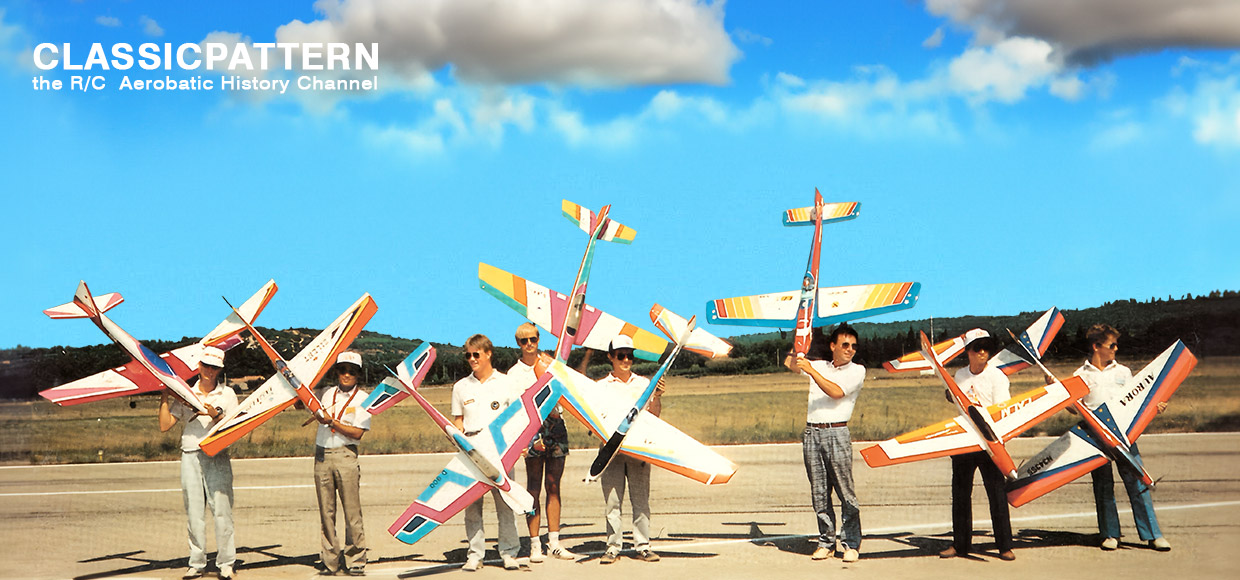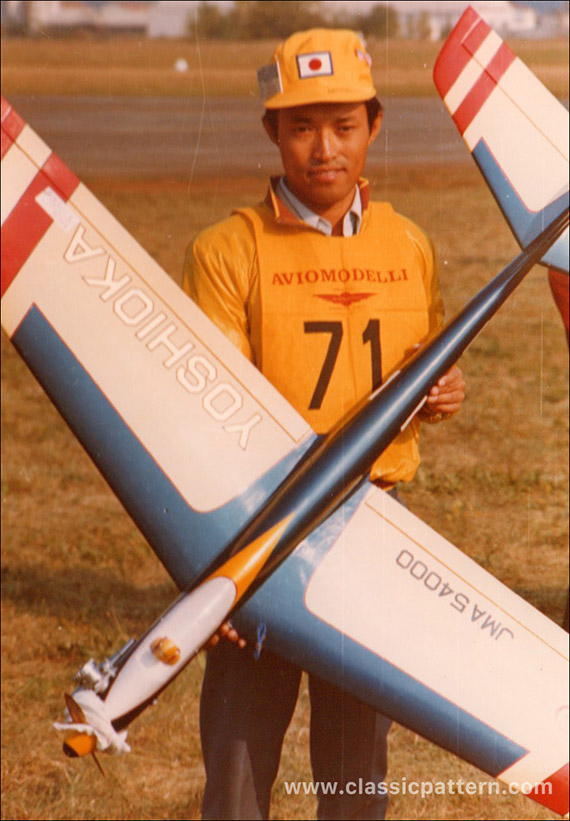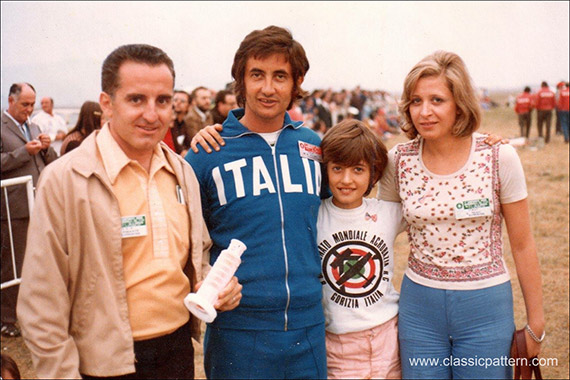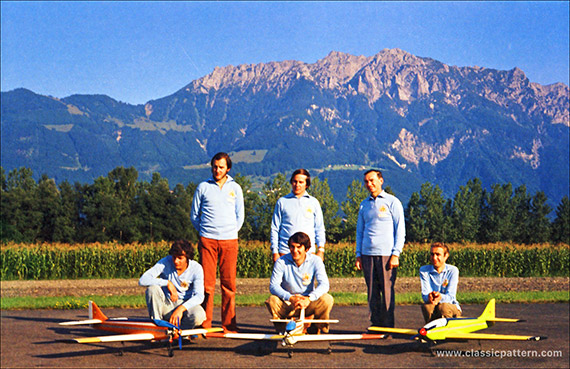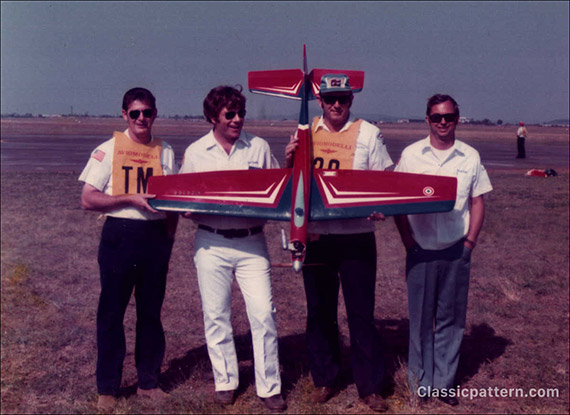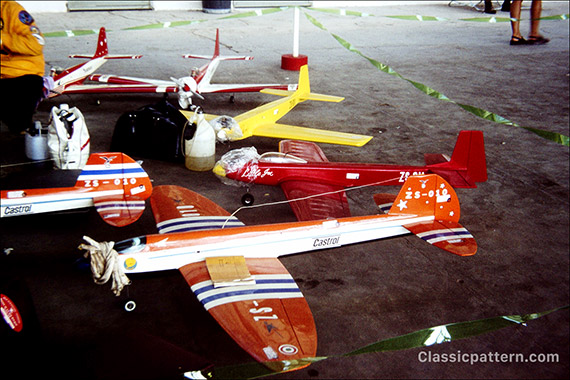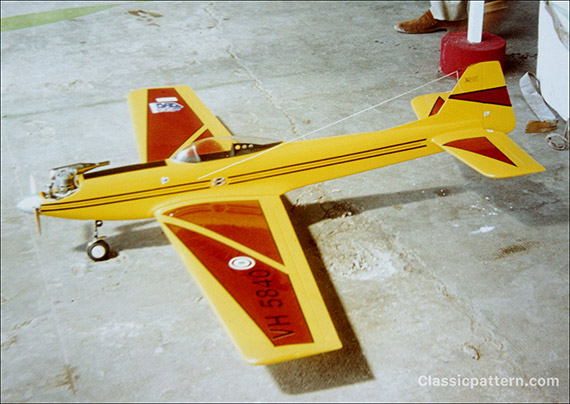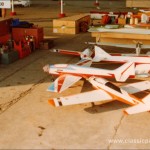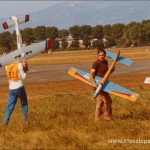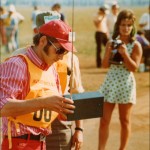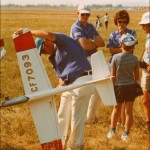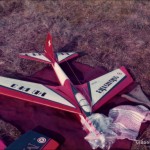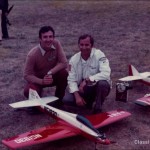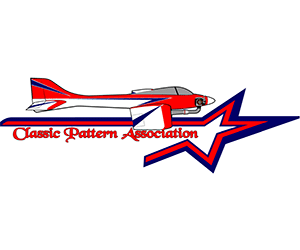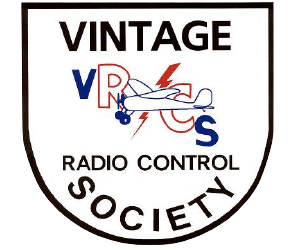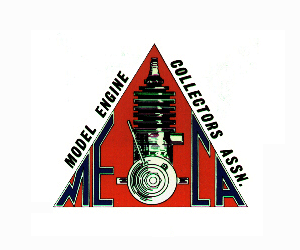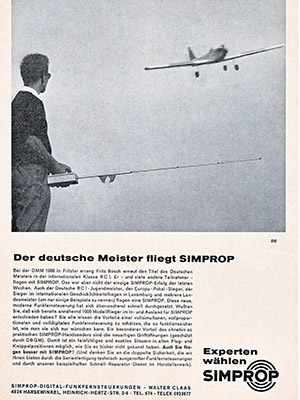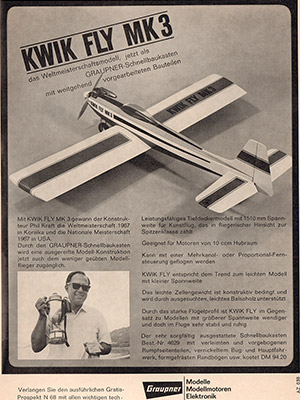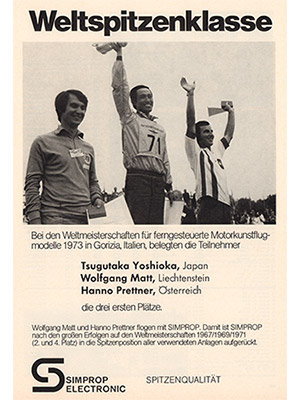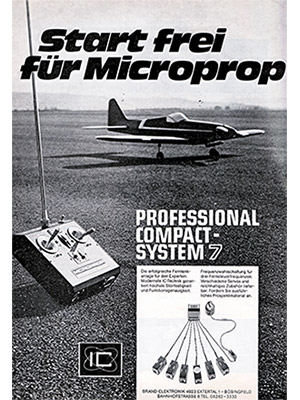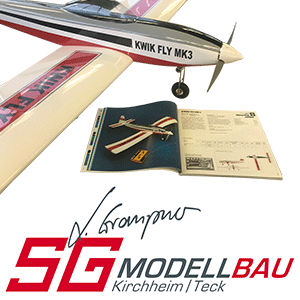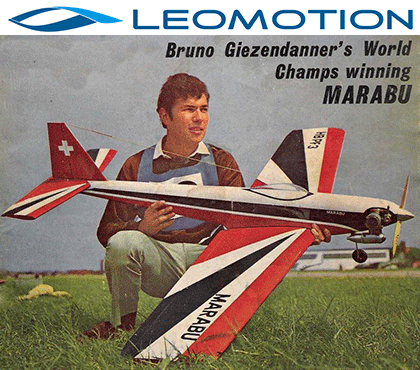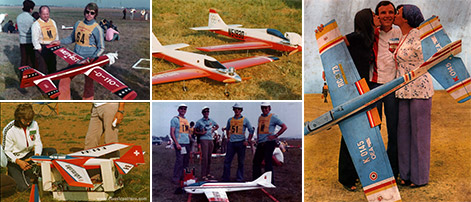
F3A World Championships 1973 Gorizia / Italia, 15 new pictures!
The 8th World Radio Control Championships for aero-batics (F.A.I. Class F3A) was a cliff-hanger to the end. It was also the largest ever of the series which began, in Switzerland, in 1960, this time drawing 78 competitors from 27 countries. Newcomers were Israel, Portugal and Spain.
`Sunny Italy’ certainly lived up to its name for at least the first three days of the event, thereafter clouding over — at times very dark indeed.
Practice day is always the time to study the flying form and to seek out interesting model design innovations, of which there were an interesting crop this time. Talking point of the meeting was certainly Bruno Giezendanner’s (winner at Bremen 1969 and Doylestown 1971) innovative new design which featured a variable geometry wing. The model, called Salamandre uses a shoulder wing position, with mainwheels in the fuselage, retracting backwards through 90 degrees into the fuselage sides, while the noseleg unit operates as normal. Wings are extended during take-off and for some manoeuvres, but are swept back for the rolls, slow, four-point and triple, the improvement of which, was the object of this very complicated exercise. In view of the disasterous effect on these manoeuvres during the four rounds of contest flying, however, it is difficult to see that the exercise achieved anything except to cost Bruno points. On the other hand, it is equally difficult to accept that such an experienced flier, twice world champion, would throw away the Chance of a hat-trick by using an un-satisfactory model and we can only conclude that Bruno was unable to use whatever advantage to design had to offer, and the latter point. Naturally there was a great deal of discussion was to whether variable geometry is legal according to F.A.I. rules, but Bruno Giezendanner was nevertheless allowed to fly. The Salamandre had one other `new’ feature — an all-flying tailplane, and was not alone since several other models also used this layout, including one of the eventual leaders, Harald Neckar of West Germany.

Neckar, in fact, was one of those who impressed us during practice flying, together with the Japanese, all of whose models were very fast indeed. It quickly became apparent that the engine has become a much more important component in the aerobatic model ‘system’. All the American team were using prototypes of a new Bill Wisniewski designed .60 motor to be made by Northfield-Ross which, with muffler, was surprisingly quiet.
British team members Mike Birch, Dave Hardaker and Dennis Hammant had settled in well, making flights early in the day which for practice and subsequent competition days began at 7 a.m. — a daunting prospect for judges!
Sonnyboy Hanno Prettner
Two flight lines were to be used for the competition, each competitor flying twice for each set of five judges.
From the total of four flights, each competitor’s poorest score would then be dropped and the remainder totalled to select five finalists for a two-round sudden death fly-off which would determine the final positions for the top five. The fly-off, on a single flight line, was to be judged by a full panel of ten judges, all of whose scores would count (no deletion of highest and lowest scores). Team results were to be calculated on the basis of the four full rounds of competition.

Round One. Thursday was a bad one for many of the top `names’. Bruno Giezendanner, the champion, was in trouble with the variable geometry Salamandre with three rolls which were so barrelled that the model exited going almost vertically down — he claimed interference and aborted the flight . . .


and his brother Emil also had no luck when the noseleg of his Marabu collapsed on take-off. Norman Page, leader of the U.S.A. team ran out of time and Wolfgang Matt the Super Star designer, 2nd at Doylestown, almost scraped a wing tip on take-off.
Hanno Prettner`s Super Sicroly
Our team leader, Mike Birch, made no such mistakes with a good flight which for a time put him in 2nd place, and the Lunch-time scoreboard’ still listed him as 3rd, proving that the `Feltham Flash’ was well in there. Dave Hardaker did not fare so well, and Dennis Hammant suffered an engine flame-out at the Cuban Eight which left him well down. One of the very pleasant surprises of Round One was the flying of Phil Soden who, as many contest fliers in this country may recall, emigrated to Canada from the Birmingham area a couple of years ago. Our loss is certainly Canada’s gain for Phil won himself a place in the Canadian team and certainly justified his selection when, at the end of the first round he was sitting pretty at joint 2nd place with Yoshioka of Japan, behind Hanno Prettner of Austria.
Tsugutaka Yoshioka, the Champion
With two flight lines in operation, however, first round scores tell a rather distorted story. In Round Two we watched Dave Hardaker make a good clean flight, although he almost lost his motor which sagged momentarily in the outside loops and he finished the flight with only a single second to spare on the stop watch! Birch’s performance in this round was also nice to watch — precise and deliberate with liberal use of throttle. He must have lost points for commencing his rolling manoeuvres late (a common fault throughout the champion-ship) and for a slightly diving straight inverted flight, but it good enough to draw in a better score than his first flight. Dennis Hammant’s cup of gall overflowed this round when he experienced a second consecutive engine cut although he at least managed to get further through the pattern this time, while David Hardaker began to find his form with an im-proved score. Impressive were Prettner again whose rolling manoeuvres are really outstanding and Matt, with Phil Soden deservedly close behind them.
Okumura, Japan with Fuji
Round Three, which commenced late on Thursday after-noon benefited from virtually windless air conditions, which Soden and Takahashi of Japan put to good use with two truly brilliant performances. In fact, the Japanese received what amounted almost to a standing ovation when his model touched down smack in the middle of the centre circle . . . the flying was that good!
Jim Martin is very busy
Meanwhile the Americans, long-time dominators of the World Champs aerobatic event were faring less well than ever before for although all were improving with each successive round, others were improving also. Big Jim Whitley for in-stance, very much the `senior citizen’ of their team flies very well, but seemed to suffer the same problem we recall at Doylestown, positioning manoeuvres too high and too far out. Also, it appears the over-large manoeuvres (and some of Jim’s looping manoeuvres were the largest we’ve seen) tend to loose reference with resultant downgrading. Jim Martin is undoubtedly the showman of the U.S. team. His Banshee mid-wing design. used by a number of other competitors is very fast and will knife edge from horizon to horizon – as he forcibly demonstrated – then will knife edge through a 180 degree turn and knife edge all the way back! For Jim though, Round Three was one of real frustration. After what may have been his best flight of four, he landed and then went searching in the grass for the spinner cap which had fallen off in flight, giving himself away in the process. Until then, no one had noticed . . . in F.A.I. competition, bits are not supposed to fall off models during flight and Jim took a big fat zero. Jim Whitley too was less than happy, having missed his spin.
The Giezendanners on the way…
Things didn’t click right for Mike Birch either resulting in a fairly untidy string of manoeuvres which produced his lowest score of the competition. But for Dennis Hammant, bingo, a whole engine run and a score which would help the British team standing. Harald Neckar, whose practice performance had impressed, now began to Show his worth with a score well over the 4,000 mark, unlike Yoshioka who produced his worst performance of the contest during this round, dropping him well below his two fellow team members Takahashi and Okamura in a scoring line-up that looked like this:
1 Prettner 12,280
2 Soden 11,740
3 Matt 11,620
4 Takahashi 11,515
5 Neckar 11,375
6 Okumura 11,370
7 Cappuyns 11,350
8 Kristensen 11,325
9 Page 11,260
10 Pasqualini 11,040
11 Yoshioka 10,995
12 Weixelbaumer 10,960
13 Bertolani 10,920
14 Birch 10,825
15 Werion 10,650
Bruno Giezendanner with his Salamandre
All three of the British team found their best form in Round Four, Birch again the best, almost topping the 4,000 point mark. This last round saw many determined do-or-die efforts with resultant noticeable all-round improvement in flying standard, as those with the most remote of chances piled an the pressure in a last-minute bid for a score which would spring them into the top five for the Sunday morning fly-off. Among these was Yoshioka whose flight, which we unfortunately missed, must have been tremendous – it was certainly the high pointer of the entire Championship. Norman Page of U.S.A. consolidated his position with another 4,000 plus score after his Round Three sparkler while both Matt and Neckar scored high.
Jim Martin`s famous Banshee
The result was a considerable switching of positions and while Hanno Prettner remained at the top of the pile, never having dropped below 4,000 points during the entire four rounds, Phil Soden had a disappointing flight which cost him a fly-off place.
Norman Page
From this last round effort emerged Hanno Prettner, who led for four whole rounds, Harald Neckar of West Germany, Yoshioka of Japan, Wolfgang Matt and Norman Page doing the biggest leapfrog in score among the five to give U.S.A. a chance at the ‘King Baudion of the Belgians’ individual winner trophy. (Such royal patronage seems rarely remembered in the heat of the competition.)
When these five assembled for the crucial two rounds early Sunday morning, they were watched by the largest and most critical audience of the whole competition.
Wolfgang Matt with Super Star
The pressure was on and first on the firing line was 21-year-old Harald Neckar, whose sleek slim fuselage model with all-flying tail broke ground and immediately sucked up the wheels. The pressure showed too because although the flight was a real pleasure to watch, there were imperfections in the Double Immelmann and the rolling manoeuvres. The tense-ness of the situation also affected Hanno Prettner and his mechanic father too. The flight by no means reflected the out-standing form a earlier rounds, drifting towards the judges in the outside loops, non-vertical entry to the Top Hat and finally resulting in disaster when Prettner Senior, nominated the start of the Landing Pattern as the Super Sicrolly was running downwind. The subsequent 180 degree turn into wind resulted in a zero score for the manoeuvre. It was a mistake which cost Hanno the Championship and Hans Prettner was visibly upset.
Kurt Matke, Germany with Olympia Flipper
Next came Wolfgang Matt, whose flight, although without serious errors did not dick — his Cuban Eight was a long way out — and scored accordingly.
Jim Fosgate from Proline Electronics with Graziano Pagni and his family
If these three were nervous, then Norman Page’s nerves must have been on the ragged edge when his Mach 1 finally took off — even with an electric starter, the engine had been reluctant to fire up and he zipped through the Pattern to make up time, lost points for climbing away across the Top Hat and set the seal with a less than perfect spin.
Jim Withley with Daddy Rabbit
Last in the round was Yoshioka who immediately almost blew the Figure M. His rolling manoeuvres were rather undulating and the depth of field in positioning rather inconsistent. His score was therefore something of a surprise for some in a line-up that looked like this:
1 Neckar 14,235
2 Yoshioka 13,920
3 Page 13,880
4 Matt 13,640
5 Prettner 13,395
Norm Page`s Mach 1
So now it all hung on one more round in which Harald Neckar, first off again lost heading in his slow roll. His four-pointer came out poor too. Prettner, next up, made no such mistakes and, showing that a setback would not get him down produced a superb performance from beginning to end — the high pointer of the fly-off.
Wolfgang Matt’s flight was also excellent throughout, little short of Prettner on points. Norman Page’s flight was one he’ll certainly never forget. What looked like a truly perfect entry into the first stall turn of the Figure M (the model really was stalled) suddenly turned into a disaster, the flight finally capped with a spiral instead of a spin at flight’s end, ruining his chances.
Harald Neckar with his Mephisto
So finally, and appropriately to the flight that settled it all. 1f one were tempted to query his first score total, there could be no questioning the second — the swept wing model came through like an express train on each low scintillating pass. the Enya 60111 burning 45 per cent nitro. The score, within 20 points of Prettner’s second, was deserved and with it Tsugutaka Yoshioka gave Japan the entire championship, the Japanese team. all three within the top ten having already secured top team position. We find it highly appropriate that the last single flight of the entire championship was the one that secured the individual trophy!
The Liechtenstein Team
Afterthoughts
Of the five finalists, it would be fair to say that anyone could have taken the championship ‘on his day’ — they were that closely matched. All were very likeable individuals. None showed quite the form seen in the first four rounds of the contest, each making mistakes, some more dramatic than others — Yoshioka made the least.
Wolfgang Matt and his Super Star
Overall, the standard of flying was by far the best ever seen at a World R/C Championship perhaps appropriate since it is likely to be the last flown to the current aerobatic schedule. The high standard in turn leads to a strange form of boredom resulting from such a repetitive high standard — a rough flight was something of a relief for spectators!
Of model design, the ‘fish’-shaped model was certainly dominant, with Wolfgang Matt’s Super Star by far the most popular. Model design and development seems to have been taken one step further with the appearance of such innovations as all-flying tailplanes. Hanno Prettner’s model used flaps which extend both above and below the wing to achieve a balance of lift and drag to slow the model down for the landing approach which is noticeably steeper than non-flap models. The flaps are also depressed for the spin.
The US Team
As noted earlier, the engine has become a much more important factor in the system which has taken the ‘European grand style’ of aerobatic flying one stage further. To achieve the very high Speeds which most of the top models now travel at, fuels contain generous amounts of additive. All the Japan-ese burned 45 per cent nitro fuel — a nitromethane content previously regarded as the kind of thing reserved for Formula One plyon racing. Some of the Americans were burning 30 per cent nitro. Throttle response is much improved with nitro additive and all the top five had superb throttle responses. The extra power is used particularly in the rolling manoeuvres which seem to stretch almost from horizon to horizon. The ‘in’ joke of the championship, that it required two visas to do a four-point roll, was not that inaccurate since Yugoslavia was just across the road from the airfield! One of the results was a notable prolonging of the rolling manoeuvres. Many competitors among the leaders prolonged the rolls far beyond the nominal five seconds quoted in the F.A.I. Sporting Code. The result is impressive and does indeed prove real pilot ability, but it’s not what the rules call for and it appeared that judges ignored the point.
Finally, a comment on the fly-off system- introduced for the event. It does work and is a spectator pleaser. However, it is very wrong to settle the first five places simply on the basis of the fly-off performances. These should be added to the scores of the preliminary rounds.
In all, a vintage World Championship, one to remember with pleasure. The clean sweep by the Japanese proves that the event is still very open — in R/C Aerobatics, it’s the pilot that matters. May it always remain so.
Images: Thank`s to Giuseppe Ghisleri, Guenter Hoppe, Graziano Pagni, Sky Aviations
Text:
| Pilot | Country | Engine | RC-Control |
| 1. T.Yoshioka | Japan | Enya 60 | Simprop |
| 2. W.Matt | Liechtenstein | HP 61 | Varioprop |
| 3. H.Prettner | Austria | Webra Speed | Degicon |
| 4. H.Neckar | West Germany | HB 61 | Simprop |
| 5. N.Page | U.S.A. | Webra Speed | Pro-Line |
| 6. P.Soden | Canada | Webra 61 | Multiplex |
| 7. Y.Takahashi | Japan | Enya 60 | Sankyo |
| 8. J.Whitley | U.S.A. | Ross 61 | Pro-Line |
| 9. T.Okumura | Japan | OS 60 | Degicon |
| 10. G.Cappuyns | Belgium | HP 61 | Kraft |
| 11. M.Birch | Great Britain | HP 61 | Skyleader |
| 12. J.Martin | U.S.A. | HP 61 | Pro-Line |
| 13. R.Pasqualini | Italy | ST G60 | Pro-Line |
| 14.I. Kristensen | Canada | Webra 61 | Multiplex |
| 15. F.Schaden | Austria | HP 61 | Digi-Fly |
| 16. G.Werion | Belgium | Rossi ABC | Kraft |
| 17. D.Hardaker | Great Britain | HP 61 | Skyleader |
| 18. W.Kosche | West Germany | HB 61 | Varioprop |
| 19. K.Weixelbaumer | Austria | HP 61 | Varioprop |
| 20. B.Bertolani | Italy | ST G60 | Robot |
| 21. M.Bruls | Holland | Webra 61 | Simprop |
| 22. K.Matke | West Germany | Webra 61 | Varioprop |
| 23. G.Pagni | Italy | ST G60 | Pro-Line |
| 24. Marincowitz | South Africa | Webra 61 | Pro-Line |
| 25. Van Gompel | Belgium | Webra 61 | Kraft |
| 26. D.Hammant | Great Britain | HP 61 | Skyleader |
| 27. W.Hitchcox | Canada | ST 61 | Orbit |
| 28. B. Giezendanner | Switzerland | Webra 61 | Digi-Fly |
| 29. K.Holm | Sweden | Webra 61 | Pro-Line |
| 30. J.Van Vliet | Holland | ST 61 | Simprop |
| 31. S.Feiner | Mexico | HP 61 | Pro-Line |
| 32. F.Markun | Yugoslavia | HB 61 | Multiplex |
| 33. Lundstrom | Sweden | HP 61 | Pro-Line |
| 34. E.Giezendanner | Switzerland | Webra 61 | Digi-Fly |
| 35. Ridderstrom | Sweden | HP 61 | Simprop |
| 36. K.Aker | Norway | HP 61 | Pro-Line |
| 37.G.Hardy | France | Rossi 60 | Simprop |
| 38. P.Stephansen | Norway | HP 61 | Kraft |
| 39. B.Angus | Australia | HP 61 | Kraft |
| 40. N.Matt | Liechtenstein | Webra Speed | Simprop |
| 41. W.Meier | Liechtenstein | HP 61 | Simprop |
| 42. K.Tromp | Holland | Webra 61 | Microprop |
| 43. B.Hedegaard | Denmark | HP 61 | Sankyo |
| 44. J.Olivier | South Africa | HP 61 | Skyleader |
| 45. J.C.Couson | France | HP 61 | Multiplex |
| 46. B.Green | Australia | ST G60 | Kraft |
| 47. J.Tracy | Australia | HP 61 | Kraft |
| 48. J.Mersch | Luxemburg | HP 61 | Varioprop |
| 49. P.Havel | Czechoslovakia | Webra 61 | Varioprop |
| 50. J.Michaelovik | Czechoslovakia | ST G60 | Varioprop |
| 51. S.Folen | Norway | Webra 61 | Skyleader |
| 52. T.Boehm | Yugoslavia | HP 61 | Kraft |
| 53. A.Elizondo | Mexico | HP 61 | Kraft |
| 54. N.Bertemes | Luxemburg | HP 61 | Varioprop |
| 55. B.Takacs | Hungary | Moki M5 | Kraft |
| 56. D.Chabert | France | Webra 61 | Simprop |
| 57. O.Harder | Denmark | HP 61 | Sankyo |
| 58. J.Beasley | Ireland | Webra 61 | Skyleader |
| 59. G.Stefel | Hungary | Moki M5 | Microprop |
| 60. P.Behm | Luxemburg | HP 61 | Simprop |
| 61. F.Buick | Ireland | HP 61 | Skyleader |
| 62. L.Mohai | Hungary | Webra 61 | Kraft |
| 63. J.Brink | South Africa | Webra 61 | Skyleader |
| 64.R. Ragoni | Switzerland | Webra 61 | Simprop |
| 65. E.Karlev | Bulgaria | HP 61 | Multiplex |
| 66. D.Stavrev | Bulgaria | Webra 61 | Multiplex |
| 67. M.Sabat | Spain | OPS 60 | Kraft |
| 68. J.Rojo Ara | Spain | Webra 61 | Multiplex |
| 69. V.Husek | Czechoslovakia | Webra 61 | Varioprop |
| 70. N.Horowitz | Israel | Veco Lee | Royal Tech |
| 71. H.Menary | Ireland | Rossi 60 | Horizon |
| 72. Mendes de Almdeida | Portugal | OS 60 | Futaba |
| 73. C.Papaspyrou | Greece | Rossi 60 | Orbit |
| 74. E.Taft | Denmark | OPS | Logictrol |
| 75. M.Merse | Yugoslavia | HP 61 | Multiplex |
| 76. R.Romojaro | Spain | Webra 61 | C.D.P. |
| 77. N.Donchev | Bulgaria | Webra 61 | Multiplex |
| 78. F.Prat | Mexico | Webra 61 | Logictrol |
Pictures
Text Copyright by:
